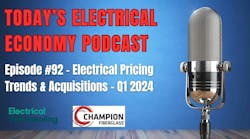One of the more popular articles published in Electrical Wholesaling over the past few years was its Feb. 2013 cover story, “10 Trends That Will Shake the Industry,” where we made our picks for the trends now having the most impact on the electrical wholesaling industry. As a follow-up to that article, next month’s EW cover story will look at the technological changes just over the next hill that could revolutionize how we work and live. Here’s a sneak preview of that article for Electrical Marketing subscribers.
Lighting links with HVAC and other building systems. Lighting, HVAC and building automation companies are blending their products together into integrated building control systems that can dramatically slash the amount of energy a commercial building consumes. Earlier this year, GE Lighting announced details of its collaboration with Trane, where its LightSweep Modular Lighting Control Solution is being integrated into the TraneTracer building automation system. Trane’s Tracer BAS is a building automation system based on open standards that integrates building systems for maximum operational and energy efficiency.
GE also developed a new series of LED lighting fixtures, the Lumination BL Series LED Luminaire, specifically for use in USG’s Logix Ceiling System. The press release announcing the launch says the fixtures are compatible with most other integrated ceiling systems in the marketplace today, and “help free architects and lighting professionals from the constraints of traditional t-grid ceiling designs,” the press release said. “These ceiling systems reimagine lighting and utilities not as exposed fixtures, but contained within narrow bands running the length of the room.”
New LED players with new ideas. Over the past five years, there’s been a dramatic move in to the LED market by Pacific Rim electronics and semiconductor companies such as Sharp, Toshiba and Panasonic. Look for another giant industrial conglomerate, Honeywell, to get bigger in lighting, too, following its Jan. 2013 announcement that it was expanding its line of LED products through its new LED Lighting Solutions business unit. The company had been in LEDs since 2008 through its Honeywell Lonon joint venture, where it outfitted more than 100 Walmarts in China with LEDs, enabling each store to reduce energy usage by their lighting systems by half.
With their backgrounds in the semiconductor, consumer electronics and building systems markets, these newcomers are strolling onto Electric Ave. with some massive R&D resources and a clean slate when it comes to marketing their products. They may use existing channels, a blend of old and new channels, or an entirely different channel strategy. That’s both a challenge an opportunity for EW’s readers.
Using gravity to create light. Word continues to spread about GravityLight, a new light source that uses an innovative weight, pulley and gearing system to generate the electricity needed to run a lamp for just over 30 minutes. Users simply load the bag that comes with the unit with sand, soil or stones and attach it to the pulley system. As the bag descends it uses gravity to create the electricity needed to power the lamp. London-based designers Martin Riddiford and Jim Reeves hope that when the GravityLight is in full production it will cost less than $5 per unit. Their research is funded in part by a crowdsourcing campaign at www.indigogo.com that raised $399,550.
OLEDs. If you have been amazed by the fast growth and future potential of LEDs, you will be totally blown away by what OLEDs could do in the lighting market if someone ever figures out a way to manufacture them cost-effectively. They are super-thin and some researchers believe they will one day be applied as a paint or other coating to walls, ceilings or virtually any other surface to light up a room. You see OLEDs in cellphone displays and cameras right now. Ten years from now distributors could be stocking and selling rolls of OLED-impregnated wallpaper to electrical contractors.
Energy storage. Being able to store electricity in batteries or other yet-to-be-created devices would smooth out the on-now, off-later power production of wind turbines and solar panels into a more dependable stream of electricity for electric utilities. GE Energy may have taken a step in this direction with the recent launch of its 2.5-120 GE Brilliant wind turbine, which it says is the first wind turbine to incorporate short-term battery storage as part of the complete turbine package.
These advances in battery storage would have a trickle-down effect into other markets, as the development of lightweight, fast-charging and dependable batteries would create a whole market niche in the supply and installation of electric-vehicle charging stations. The need for better battery storage has attracted the attention of the Department of Energy (DOE), and the federal government is funding the development of high-capacity storage batteries with the recent launch of what it calls its “Batteries and Energy Storage Hub” at the Joint Center for Energy Storage Research (JCESR) at the famed Argonne National Lab in Lemont, Ill. The lab, which received up to $120 million over five years, is focusing on applications in the transportation and grid sectors.
The smart grid. Electric utilities are spending millions of dollars on the smart meters that will enable their customers to monitor their energy usage more closely. There’s more smart meters already installed than you probably realize. According to “Utility Scale Smart Meter Deployment, Plans & Proposals,” a report published in 2012 by the Edison Foundation, as of May 2012, 36 million smart meters have been installed and 65 million smart meters will be deployed in total by 2015. One of the larger installations is now underway at ComEd in Chicago, which recently announced that it would be purchasing approximately 4 million smart meters from GE over the next eight years in a deal worth more than $200 million.
You want it? You print it. If you have an eye for some of the hottest tech stocks, you are probably already watching companies like 3D Systems and Stratasys, which have taken the three-dimensional modeling of prototypes to the next level with printers that allow consumers and homeowners to “print out” an amazing array of products. These 3D printers use resins similar to what’s used in injection-molded ABS plastics to produce actual products and prototypes, and you can print out plastic products like cable ties, receptacle boxes and nonmettalic fittings.
These printers are already cranking out caps in the dental industry and parts in the aerospace industries; prosthetics; and all sorts of injection-molded plastic products. While it’s tough to imagine that a contractor will use a 3D printer on a jobsite to print out a few junction boxes or cable ties, as 3D manufacturing matures and developers expand the types of materials their printers can use, the sky’s the limit on what could be produced. NASA has already figured out how to “print out” food for space missions, and at least one 3D researcher has already printed out chocolate for his wife.









